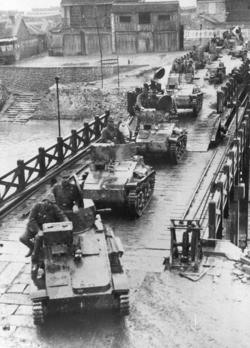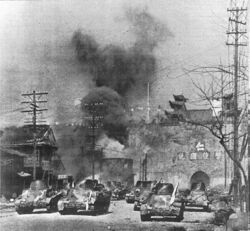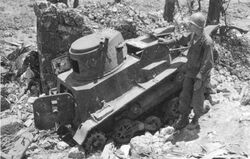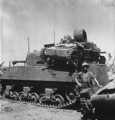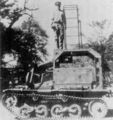Engineering:Type 94 tankette
| Type 94 TK | |
|---|---|
 Type 94 tankette at Armor School History Museum | |
| Type | Tankette |
| Place of origin | Empire of Japan |
| Service history | |
| Used by | Imperial Japanese Army National Revolutionary Army Chinese Red Army Manchukuo Imperial Army |
| Production history | |
| Designed | 1932 |
| Unit cost | 25,300 yen ($6,798 USD) in August 1939, excluding armament[1][2] |
| Produced | 1935–1937 |
| No. built | 823[3] |
| Specifications | |
| Mass | 3.4 tonnes (3.35 long tons; 3.75 short tons) [4] |
| Length | 3.08 m (10 ft 1 in) [4] |
| Width | 1.62 m (5 ft 4 in) [4] |
| Height | 1.62 m (5 ft 4 in) [4] |
| Crew | 2 (commander, driver) [5] |
| Armour | 8–12 mm (0.31–0.47 in) [6] |
Main armament | 6.5mm Type 91 machine gun [4] |
Secondary armament | None |
| Engine | Mitsubishi Franklin air-cooled inline 4-cylinder Gasoline 32 hp (24 kW) [4] |
| Power/weight | 9 hp/tonne (6.7 kW/tonne) |
| Suspension | 2-wheel bogie |
Operational range | 200 km (120 mi) [4] |
| Speed | 40 km/h (25 mph) [4] |
The Type 94 tankette (Japanese: 九四式軽装甲車, romanized: Kyūyon-shiki keisōkōsha, literally "94 type light armored car"; also known as TK, an abbreviation of Tokushu Keninsha, literally "special tractor"[7]) was a tankette used by the Imperial Japanese Army in the Second Sino-Japanese War, at Nomonhan against the Soviet Union, and in World War II. Although tankettes were often used as ammunition tractors, and general infantry support, they were designed for reconnaissance, and not for direct combat.[8] The lightweight Type 94 proved effective in China as the Chinese National Revolutionary Army had only three tank battalions to oppose them, and those tank battalions were equipped only with some British export models and Italian CV-33 tankettes.[9] As with nearly all tankettes built in the 1920s and 1930s, they had thin armor that could be penetrated by .50 caliber (12.7 mm) machine gun fire at 600 yards (550 m) range.[10]
History and development
From the 1920s, the Imperial Japanese Army tested a variety of European light tanks, including several Renault FTs, and a decision was reached in 1929 to proceed with the domestic development of a new vehicle based largely on the Carden-Loyd Mk VI tankette design to address the deficiencies of wheeled armored cars.[11]
The initial attempt resulted in the Type 92 Jyu-Sokosha for use by the cavalry. However, Japanese infantry commanders felt that a similar vehicle would be useful as the support vehicle for transport, scout and communications within the infantry divisions.[12]
A tankette fad occurred in Europe in the early 1930s, which was led by United Kingdom's Carden-Loyd Mk VI tankette.[7] The IJA ordered six samples from the UK, along with some French Renault UE Chenillette vehicles and field tested them.[7] The IJA determined that the British and French machines were too small to be practical, and started planning for a larger version, the Tokushu Keninsha (TK, meaning "Special Tractor").[7] The Imperial Japanese Army also experimented with a variety of armored cars with limited success. The wheeled armored cars were not suitable for most operations in the puppet state of Manchukuo, due to the poor road conditions and severe winter climate.[13]
The design of the Type 94 began in 1932. Development was given to Tokyo Gas and Electric Industry (later known as Hino Motors) in 1933, and an experimental model was completed in 1934. It was a small light tracked vehicle with a turret armed with one machine gun.[14] For cargo transportation it pulled an ammunition trailer.[15] After trials in both Manchukuo and Japan, the design was standardized. It was reclassified as the Type 94 (Type 2594; tankette) and was designed for reconnaissance,[8] but could also be used for supporting infantry attacks and transporting supplies.[14] It entered service in 1935. The Type 94 was later superseded by the Type 97 Te-Ke tankette, which was designed as a fast reconnaissance vehicle.[16]
Oddly, many British and American sources have confused the Type 92 Cavalry Tank, of which only 167 were built[3] with the Type 94, although the Type 94 was the model almost always encountered in the various fronts of the Pacific War.[17]
Design
The design of the Type 94 was inspired by the British Carden-Loyd Mark VIb tankettes. The IJA received delivery of six of these in 1930. Although the Japanese determined that both the Mark VIb and the French Renault UE were too small, they liked certain features of each of them. The design of the Type 94 had more similarities with the Vickers light tanks of the time.[18] The hull of the Type 94 was of riveted and welded construction, with a front-mounted engine with the driver to the right. The engine was an air-cooled petrol motor that developed 35 hp (26 kW) at 2,500 rpm. Like many Japanese armored vehicles intended to operate in hot conditions, the engine was given asbestos insulation to protect the occupants from its heat. The commander stood in a small (unpowered) turret at the rear of the hull. A large door in the rear of the hull accessed the storage compartment.
Initially, the armament was a Type 91 6.5×50mm machine gun, although later models carried a Type 92 7.7 mm machine gun.[7] The suspension consisted of four bogies - two on each side. These were suspended by bell-cranks resisted by externally placed armored compression springs placed horizontally, one each side of the hull. Each bogie had two small rubber road wheels with the drive sprocket at the front and the idler at the rear.[19] There were two track-return rollers. In combat service the Type 94 was found to be prone to throwing its tracks in high speed turns. Further redesign work was carried out in 1937 on the suspension and the small idler was replaced by a larger diameter idler wheel suspended from a rocker arm that was now in ground contact;[19] it did not completely solve the problem. Later models of the Type 94 had a revised suspension with the larger diameter idler wheel on a longer chassis. This increased the length of the tankette to 3.35 m (11 ft 0 in).
Variants
Several variants of the Type 94 were produced. These included the Type 94 "Disinfecting vehicle" and Type 94 "Gas scattering vehicle", which were adapted for chemical warfare.[14][20] Others produced were the "Type 97 Pole planter" and "Type 97 Cable layer". These used the Type 94 chassis, with the former vehicle first planting a telegraph pole and then the latter vehicle laying the telegraph cable.[21]
Operational service
The Type 94 was mainly deployed in "Tankette Companies". They were attached to infantry divisions for use in the reconnaissance role. Each Japanese division had four tankette platoons, with four tankettes in each platoon.[14] The Type 94 Tankette was an inexpensive vehicle to build, at approximately half the price of the Type 95 Ha-Go light tank, resulting in more Type 94's entering service than any other Japanese tankette (823 units).[22] Production included 300 units in 1935, 246 units in 1936, 200 units in 1937 and 70 units in 1938.[3] The lightweight Type 94 was "tailored" for operating in China and proved to be effective for infantry support and reconnaissance by infantry divisions.[7][19] Given the utility of the design in combat in China, the Imperial Japanese Army was therefore content to retain the Type 94, although the design, and indeed the concept of the tankette, came to be regarded as obsolescent in Western armies.
With the start of World War II, a number of Type 94s were issued to each Japanese infantry division in the Pacific theatre, with a tracked trailer. They saw action in Burma, the Netherlands East Indies,[23] the Philippines and on a number of islands in the South Seas Mandate. Some were also assigned to Imperial Japanese Navy Land Forces. A detachment of eight Type 94 tankettes forming the 56th Infantry Group Tankette Unit (Also named the Anai tankette unit, after the name of their captain), part of the "Sakaguchi Detachment", had a notable role in the Japanese conquest of Java, engaging a large enemy element on 2 March and routing them, capturing a bridge on the same night, and at dawn overrunning a position of 600 enemy soldiers on the opposite bank, and participating in offensive operations that led to the surrender of Dutch forces on the next few days near Surakarta. The Sakaguchi detachment, along with the Shoji detachment, would receive a thanks letter from their parent unit (the 16th Army) for their actions in the campaign, the only units to receive them.[24]
In 1941, the Wang Jingwei regime's army was given eighteen Type 94 tankettes.[25] In 1943 ten Type 94 tankettes were given to the Manchukuo Imperial Army to form an armored company. They were still in use until as late as 1945.[26]
Major deployments included:
- Hebei, China: 1st Tank Battalion and 2nd Tank Battalion
- Chahar Province, China: 1st Independent Mixed Brigade
- Shanghai, China: 5th Tank Battalion
- Tai'erzhuang, China: Special Tank Company of China Detachment Tank Unit
- Xuzhou, China: 1st Tank Battalion and 5th Tank Battalion
- Nomonhan, Manchukuo: 3rd Tank Regiment and 4th Tank Regiment
- Xinjing, Manchukuo: Armored unit of Imperial Manchukuo Army
- Nanjing, China: Armored unit of the Nanjing Regime
- Timor: IJA 38th Division Tankette Company[27]
- Java: Anai Tankette unit, 2nd, 3rd and 48th Recon Regiment, Sakaguchi Detachment, 56th Infantry Group Tankette Unit[28][29]
- Kwajalein Atoll: 2nd Battalion of Army 1st Sea-mobile Brigade
Survivors
Type 94[30]
- The Wheatcroft Collection, Leicestershire, UK
- Patriot Park, Kubinka, Russia
- Tank Museum, Beijing, China
- Armor Training Command R.O.C. Army, Hukou, Taiwan
- Treloar Resource Centre, Canberra, Australia
Type 97 Pole Planter[30]
- Kokopo War Museum, Kokopo, Papua New Guinea
Gallery
A captured Type 94 tankette with a damaged turret, on the engine deck of a USMC M4 Sherman tank at Kwajalein
Comparable vehicles
- Germany: Panzer I
- Italy: L3/35
- Romania: R-1
- Poland: TK-3 and TKS
- Soviet Union: T-27 • T-37A • T-38
- Sweden: Strv m/37
- United Kingdom: Light Tank Mk VI
Notes
- ↑ "兵器臨時定価、予価、表送付の件 Military catalogue of the Japanese military". Ministry of the Army. https://www.jacar.archives.go.jp/aj/meta/listPhoto?LANG=eng&BID=F2006083120452299318&ID=M2006083120453599356&REFCODE=C01004699100.
- ↑ Banking and Monetary Statistics, 1914-1941, Part I. Board of Governors of the Federal Reserve System (U.S.). January 1943. https://fraser.stlouisfed.org/title/38#6408.
- ↑ 3.0 3.1 3.2 Zaloga 2007, p. 10.
- ↑ 4.0 4.1 4.2 4.3 4.4 4.5 4.6 4.7 Tomczyk 2002, p. 55.
- ↑ Tomczyk 2002, p. 54.
- ↑ Tomczyk 2002, pp. 54, 55.
- ↑ 7.0 7.1 7.2 7.3 7.4 7.5 Zaloga 2007, p. 7.
- ↑ 8.0 8.1 Coox 1985, pp. 154, 157.
- ↑ Zaloga 2007, p. 12.
- ↑ Report on Type 92 from September 1945 issue of Intelligence Bulletin
- ↑ Foss 2003b, p. 220.
- ↑ Tomczyk 2002, pp. 46, 54.
- ↑ Taki's Imperial Japanese Army
- ↑ 14.0 14.1 14.2 14.3 Zaloga 2007, p. 8.
- ↑ Tomczyk 2002, pp. 39, 46.
- ↑ Tomczyk 2002, pp. 55, 57.
- ↑ Foss 2003a, p. 106.
- ↑ Zaloga 2007, pp. 7, 8.
- ↑ 19.0 19.1 19.2 Tomczyk 2002, p. 46.
- ↑ Taki's Imperial Japanese Army: Type 94 Disinfecting Vehicle and Type 94 Gas Scattering Vehicle
- ↑ Taki's Imperial Japanese Army: Type 97 Pole Planter and Type 97 Cable Layer
- ↑ Zaloga 2007, pp. 8, 10.
- ↑ Takizawa, Akira (1999–2000). "The Japanese Armoured Units in the Dutch East Indies 1941-1942". Forgotten Campaign: The Dutch East Indies Campaign 1941-1942. https://warfare.gq/dutcheastindies/japarmunits.html.
- ↑ Takizawa, Akira (1999–2000). "Japanese Armoured Units on Java Island, 1942". Forgotten Campaign: The Dutch East Indies Campaign 1941-1942. https://warfare.gq/dutcheastindies/java_armour.html.
- ↑ Jowett, Philip S. (2004). Rays of the Rising Sun: Armed Forces of Japan's Asian Allies 1931-45: Volume 1: China and Manchukuo. Helion & Company Limited. p. 76.
- ↑ Mahé, Yann (October 2015). "Le Blindorama: Mandchoukouo, 1932 - 1945" (in fr). Batailles & Blindés (Caraktère) (48): 4–7. ISSN 1765-0828.
- ↑ Takizawa, Akira (1999–2000). "Japanese Armoured Units on Timor Island, 1942". Forgotten Campaign: The Dutch East Indies Campaign 1941-1942. https://warfare.gq/dutcheastindies/timor_armour.html.
- ↑ L, Klemen (1999–2000). "The Use of Armoured Vehicles on Borneo, 1941-19422". Forgotten Campaign: The Dutch East Indies Campaign 1941-1942. https://warfare.gq/dutcheastindies/borneo_armour.html.
- ↑ Takizawa, Akira (1999–2000). "Japanese Armoured Units on Java Island, 1942". Forgotten Campaign: The Dutch East Indies Campaign 1941-1942. https://warfare.gq/dutcheastindies/java_armour.html.
- ↑ 30.0 30.1 "Surviving Japanese Light Tanks". http://the.shadock.free.fr/Surviving_Panzers.html.
References
- Coox, Alvin D. (1985). Nomonhan: Japan Against Russia, 1939 (Two volumes). Stanford University Press. ISBN 0-8047-1160-7.
- Foss, Christopher (2003a). Great Book of Tanks: The World's Most Important Tanks from World War I to the Present Day. Zenith Press. ISBN 0-7603-1475-6.
- Foss, Christopher (2003b). Tanks: The 500. Crestline. ISBN 0-7603-1500-0. https://archive.org/details/tankstanksofworl0000foss.
- Tomczyk, Andrzej (2002). Japanese Armor Vol. 1. AJ Press. ISBN 83-7237-097-4.
- Zaloga, Steven J. (2007). Japanese Tanks 1939–45. Osprey. ISBN 978-1-8460-3091-8.
External links
 |
